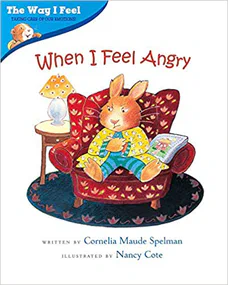When I Feel Angry
Written by Cornelia Maude Spelman
Illustrated by Nancy Cote
24 pages
•
Published 2000 (Albert Whitman & Company)

Recommended Age Range: Preschool through 2nd grade.
Publisher's Summary:
Everyone feels angry sometimes, but there are always ways to feel better! Join a bunny rabbit and her family as she learns to manage angry feelings. With a focus on identifying the causes of an emotional reaction, and coming up with ways to start feeling calm and happy again, this book explains simple strategies to help kids understand and take care of their emotions.

Dr. Annie's Takeaways
Recommended for: This book is a really great introduction to anger management and would probably be best received by a child who has expressed some interest in getting a better handle on their anger (maybe they want to get in trouble less, or they’ve expressed sadness about hurting someone’s feelings while they were angry). Importantly, it teaches children to listen to their anger (e.g., maybe a child needs a rest or someone needs to stop being unfair) as well as to calm down using a handful of impactful coping strategies (e.g., taking a break, deep breaths, exercise, talking with a trusted person).
Would a child like it? Anger is often a scary feeling for children, and this book reassures a child that anger is important and that there are things they can do to prevent it from getting out of control. It’s not a particularly fun book, but a child who wants to learn to tame their anger would likely find it soothing.
Evidence-Based Practices:
Emotional Literacy, Diaphragmatic Breathing, Self-Soothing, Emotional Processing
Tone: Matter-of-fact, empowering
Story Quality: This story is written in the first person, in short, often affirmative sentences (e.g., “I might need help figuring it out. Then I can change what I’m doing. Or tell someone else what I need. I can listen to the other person tell too”). It’s a very effective style–it’s clear and models validating, empowering self-talk.
Illustrations: Cute, if a bit old-fashioned, watercolor illustrations of anthropomorphized bunnies.
Representation: The main character is a young female bunny. She is pictured wearing some traditionally feminine clothing (e.g., dresses) but her interests are not stereotypically gendered (i.e., she enjoys riding her bike, looking at bugs, and playing softball). She has a mother and father bunny, as well as a baby sibling, and she goes to school with different species of animals. One of her classmates is a cat with a leg brace and crutches.
Psychological Practices: This book is a really lovely introduction to the idea that anger is an important, useful emotion and that with practice, children can learn to manage it so that it doesn’t get out of control and hurt the child or someone else. It teaches children what anger feels like; which situations might provoke a child’s anger (e.g., kids teasing, being unfairly accused of something, feeling frustrated when something doesn’t turn out the way a child wanted); that having an aggressive thought is okay but acting on it isn’t; and how a child can calm their anger (i.e., step away, take deep breaths, exercise, do something fun, share feelings and listen to others’ feelings). I particularly love how this book teaches children that anger is an important feeling to listen to: “…sometimes when I feel angry it means something needs to be different. Maybe it’s me. Maybe I need to rest or cry. Maybe someone else needs to be different. Maybe someone needs to be nicer to me or to stop being unfair.” It’s a very important message that is often underrepresented in children’s books on anger.
Concerns: None.
